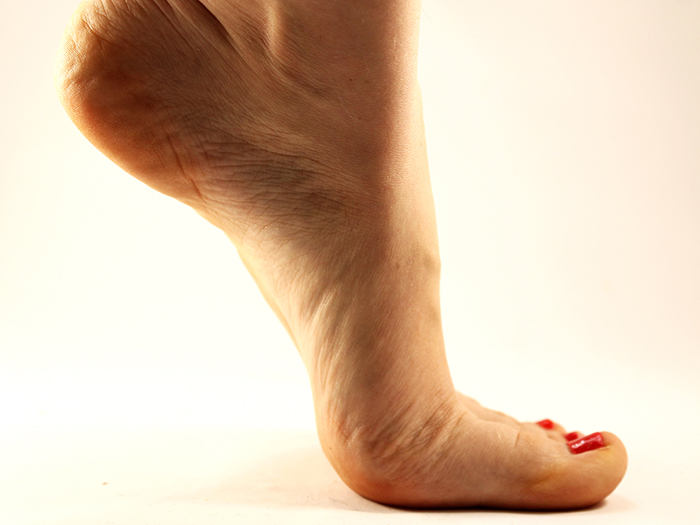4 Foot Exercises You Should Do Today
Because staying mobile and independent starts with your feet.

What’s the secret to staying mobile and independent? You’re standing on it. That’s right (and left): Your feet form the foundation for whole-body health and mobility.
“If you don’t have full range of motion in your base of support, either because of restrictive footwear or unfit feet, then all your other joints and muscles have to compensate,” says Katy Bowman, M.S., biomechanist and coauthor of Dynamic Aging: Simple Exercises for Whole-Body Mobility.
This compensation may be especially noticeable during exercise, but most of our daily locomotion depends on the strength and stability of our feet, Bowman says.
Any weakness or immobility in the feet can cause pain farther up, mainly in the knees, hips, back, and neck. Over time, poor foot fitness may lead to a host of issues, including arthritis, bunions, plantar fasciitis, stiffness, cramping, numbness, and tingling—all things that make everyday movement increasingly difficult and dampen quality of life.
“Because almost all upright motions are done using the foot, foot pain or stiffness can quickly become the reason you no longer get up out of your chair,” Bowman says. “Walking becomes too difficult; even driving can be too physically taxing.”
And even if you do stand up and walk, many older adults eventually stop taking a full stride or picking their feet up off the floor. This further weakens the feet and by extension the legs, making you less capable of adapting when you encounter a stray power cord or a crack in the sidewalk, thereby increasing risk of falls.
What Causes Poor Foot Fitness
“Footwear is a major contributor to foot weakness that leads to falls in older adults,” says Lynn Shuck, a Minnesota-based yoga instructor who focuses on alignment and strengthening underused muscles.
Many older adults try to protect against falls by transitioning to excessively stiff, heavily cushioned shoes the minute their feet lose strength and mobility. “But when your shoes are stiff,” she says, “your ankle then has to do the work of accommodating anything that comes up in your walking path, versus your foot being able to handle it.”
Why that’s bad: Each foot boasts 33 joints, 26 bones, and more than 100 muscles, tendons, and ligaments—and every piece is designed to navigate uneven surfaces.
“If they can’t do it, your ankle has to,” Shuck says. “And often, you either break your ankle or you fall down.” Both bad options.
Improve Your Foot Fitness with the Right Shoes
Maintaining independence starts with foot fitness, and foot fitness starts with your footwear. For most people, this means choosing shoes that provide the right balance of flexibility and support. The American Podiatric Medical Association recommends enough toe flexibility to allow natural foot motion and heels that are stiff enough to provide support.
What not to do: toss out all of your shoes and orthotics, and buy the most minimal pair you can find. If you go from a stiff orthotic shoe straight into a flat pair with minimal cushioning, you’ll likely cause pain and injury, Shuck says. The transition should be gradual so your feet can relearn how to do their job.
If you have any conditions (including osteoporosis and diabetes), foot problems, or balance issues, work with your doctor to stay comfortable and steady on your feet. And if you have balance issues, wearing shoes to walk around at home—instead of bare feet, socks, or slippers—can help protect you from falls.
Strengthen Your Feet with These Exercises
In addition to swapping out any excessively stiff shoes for a more flexible pair, start incorporating some foot strength and mobility exercises into your regular routine, like the four below.
For best results, do these exercises every day or at least every other day. Shuck recommends tacking them onto the end of your regular walk or exercise routine: As soon as you get home, take off your shoes and socks, and perform the drills. You’ll be finished in less than 10 minutes!
1. Folded Blanket Walk
If you have balance issues, check with your doctor first, or skip this move.
If this move is safe for you, stand next to a chair or wall for support, and place a folded blanket on the floor in front of you. The thicker the blanket, the more challenging the drill will be.
Step onto the blanket with both feet. Begin walking in place or back and forth on the blanket. Continue for two to three minutes, holding onto the chair or wall for support if needed.
Subscribe to our newsletter
It's quick and easy. You could be one of the 13 million people who are eligible.
Already a member? Click to discover our 15,000+ participating locations.
Follow Us
2. Rolling Feet on a Ball
Place a tennis or lacrosse ball on the floor, and sit tall in a chair. Lift your right foot, and place your heel on top of the ball. Begin rolling your foot over the ball, making sure to cover every inch until you get to your toes, and then reverse the movement. Continue rolling for two minutes, then switch feet and repeat.
Move slowly: If you lose control of the ball, you’re going too fast.
3. Seated Calf Stretch
Sit in a chair with your right leg straight out in front of you, heel touching the floor. Place a towel or resistance band around the ball of your foot, and hold the ends. Sit up tall.
Gently pull your toes and ankle up toward you, and pull through the towel or band to increase the stretch in the back of your calf. Hold for 30 seconds before switching sides. Repeat two to three times per leg.
4. Toe Lift
While sitting or standing, focus on lifting each toe individually, keeping the others on the floor and not using your hands to help. Move through all five toes on your right foot and then switch to your left.
Don’t worry if you can’t lift every toe. You’ll still reap the benefits by simply bringing awareness to a part of your body that’s not used to moving.
Take Your Favorite SilverSneakers Classes Online!
SilverSneakers members can access live fitness classes and wellness workshops through SilverSneakers LIVE. See the latest schedule and RSVP for classes here.
Not a member? If you have a Medicare Plan, it may include SilverSneakers—at no additional cost. Check your eligibility instantly here.





